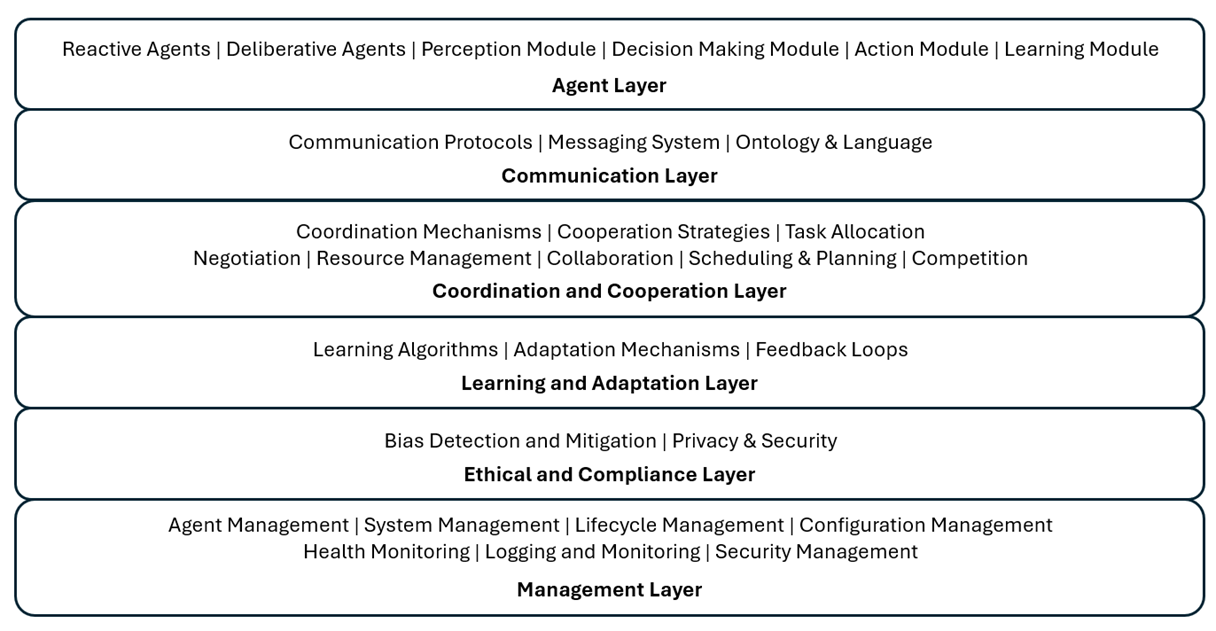Multi-Agent System (MAS) Reference Architecture
The reference architecture of a multi-agent system (MAS) consists of several layers and components that enable the agents to interact, coordinate, and perform tasks autonomously. Here's a detailed outline of a typical MAS architecture:

Agent Layer
- Agent Types:
- Reactive Agents: Respond to environmental changes in real-time.
- Deliberative Agents: Plan actions based on a model of the world and their goals.
- Hybrid Agents: Combine reactive and deliberative approaches.
- Agent Modules:
- Perception Module: Gathers and processes sensory information from the environment.
- Decision-Making Module: Determines the agent's actions based on its goals and the current state.
- Action Module: Executes the chosen actions in the environment.
- Learning Module: Adapts the agent's behavior based on experiences and feedback.
Communication Layer
- Communication Protocols: Define the rules for information exchange between agents (e.g., TCP/IP, HTTP, custom protocols).
- Messaging System: Facilitates asynchronous message passing and ensures reliable delivery of messages.
- Ontology and Language: Common vocabulary and syntax for agents to understand each other (e.g., FIPA-ACL, KQML).
Coordination and Cooperation Layer
- Coordination Mechanisms:
- Task Allocation: Distributes tasks among agents based on their capabilities and current workload (e.g., Contract Net Protocol).
- Resource Management: Manages shared resources to prevent conflicts and ensure efficient utilization.
- Scheduling and Planning: Coordinates the timing of actions and plans to achieve collective goals.
- Cooperation Strategies:
- Negotiation: Agents negotiate to reach mutually beneficial agreements.
- Collaboration: Agents work together towards common objectives.
- Competition: Agents compete for resources or tasks in a controlled manner.
Learning and Adaptation Layer
- Learning Algorithms: Machine learning techniques to enable agents to learn from their interactions and experiences.
- Adaptation Mechanisms: Methods for agents to adjust their behavior based on new information and changing environments.
- Feedback Loops: Mechanisms to provide feedback from the environment and other agents to support learning and adaptation.
Ethical and Compliance Layer
- Bias Detection and Mitigation:
- Fairness Algorithms: Ensures decisions and actions are fair and unbiased.
- Regular Audits: Conducts regular audits to detect and mitigate biases.
- Privacy and Security:
- Data Protection Mechanisms: Ensures user data privacy and compliance with regulations (e.g., GDPR, CCPA).
- Secure Communication: Secures data transmission and storage
Management Layer
- Agent Management:
- Lifecycle Management: Handles the creation, execution, monitoring, and termination of agents.
- Health Monitoring: Tracks the status and performance of agents.
- System Management:
- Configuration Management: Manages system settings and parameters.
- Logging and Monitoring: Records system activities and performance metrics.
- Security Management: Ensures secure communication, data integrity, and authentication.